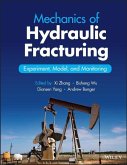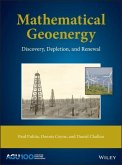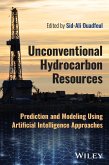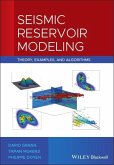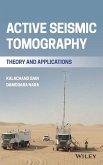- Gebundenes Buch
- Merkliste
- Auf die Merkliste
- Bewerten Bewerten
- Teilen
- Produkt teilen
- Produkterinnerung
- Produkterinnerung
Advances in theories, methods and applications for shale resource use
Shale is the dominant rock in the sedimentary record. It is also the subject of increased interest because of the growing contribution of shale oil and gas to energy supplies, as well as the potential use of shale formations for carbon dioxide sequestration and nuclear waste storage.
Shale: Subsurface Science and Engineering brings together geoscience and engineering to present the latest models, methods and applications for understanding and exploiting shale formations.
Volume highlights include: _ Review of…mehr
Andere Kunden interessierten sich auch für
![Mechanics of Hydraulic Fracturing Mechanics of Hydraulic Fracturing]() Mechanics of Hydraulic Fracturing178,99 €
Mechanics of Hydraulic Fracturing178,99 €![Mathematical Geoenergy Mathematical Geoenergy]() Paul PukiteMathematical Geoenergy218,99 €
Paul PukiteMathematical Geoenergy218,99 €![Unconventional Hydrocarbon Resources Unconventional Hydrocarbon Resources]() Unconventional Hydrocarbon ResourcesUnconventional Hydrocarbon Resources208,99 €
Unconventional Hydrocarbon ResourcesUnconventional Hydrocarbon Resources208,99 €![Quantifying Uncertainty in Subsurface Systems Quantifying Uncertainty in Subsurface Systems]() Quantifying Uncertainty in Subsurface Systems208,99 €
Quantifying Uncertainty in Subsurface Systems208,99 €![Seismic Reservoir Modeling Seismic Reservoir Modeling]() Dario GranaSeismic Reservoir Modeling121,99 €
Dario GranaSeismic Reservoir Modeling121,99 €![Time-Frequency Analysis of Seismic Signals Time-Frequency Analysis of Seismic Signals]() Yanghua WangTime-Frequency Analysis of Seismic Signals162,99 €
Yanghua WangTime-Frequency Analysis of Seismic Signals162,99 €![Active Seismic Tomography Active Seismic Tomography]() Kalachand SainActive Seismic Tomography137,99 €
Kalachand SainActive Seismic Tomography137,99 €-
-
-
Advances in theories, methods and applications for shale resource use
Shale is the dominant rock in the sedimentary record. It is also the subject of increased interest because of the growing contribution of shale oil and gas to energy supplies, as well as the potential use of shale formations for carbon dioxide sequestration and nuclear waste storage.
Shale: Subsurface Science and Engineering brings together geoscience and engineering to present the latest models, methods and applications for understanding and exploiting shale formations.
Volume highlights include:
_ Review of current knowledge on shale geology
_ Latest shale engineering methods such as horizontal drilling
_ Reservoir management practices for optimized oil and gas field development
_ Examples of economically and environmentally viable methods of hydrocarbon extraction from shale
_ Discussion of issues relating to hydraulic fracking, carbon sequestration, and nuclear waste storage
Shale is the dominant rock in the sedimentary record. It is also the subject of increased interest because of the growing contribution of shale oil and gas to energy supplies, as well as the potential use of shale formations for carbon dioxide sequestration and nuclear waste storage.
Shale: Subsurface Science and Engineering brings together geoscience and engineering to present the latest models, methods and applications for understanding and exploiting shale formations.
Volume highlights include:
_ Review of current knowledge on shale geology
_ Latest shale engineering methods such as horizontal drilling
_ Reservoir management practices for optimized oil and gas field development
_ Examples of economically and environmentally viable methods of hydrocarbon extraction from shale
_ Discussion of issues relating to hydraulic fracking, carbon sequestration, and nuclear waste storage
Produktdetails
- Produktdetails
- Geophysical Monograph Series 245
- Verlag: American Geophysical Union / Wiley & Sons
- Artikelnr. des Verlages: 1W119066680
- 1. Auflage
- Seitenzahl: 320
- Erscheinungstermin: 15. Oktober 2019
- Englisch
- Abmessung: 279mm x 218mm x 20mm
- Gewicht: 1111g
- ISBN-13: 9781119066682
- ISBN-10: 1119066689
- Artikelnr.: 43676079
- Geophysical Monograph Series 245
- Verlag: American Geophysical Union / Wiley & Sons
- Artikelnr. des Verlages: 1W119066680
- 1. Auflage
- Seitenzahl: 320
- Erscheinungstermin: 15. Oktober 2019
- Englisch
- Abmessung: 279mm x 218mm x 20mm
- Gewicht: 1111g
- ISBN-13: 9781119066682
- ISBN-10: 1119066689
- Artikelnr.: 43676079
Thomas Dewers' research interests and experience range from theoretical coupled thermal-mechanical-hydrological-chemical modeling, high temperature-high pressure and rock mechanics experimental methods, field investigations for geomicrobiology and hydrogeology, induced seismicity, and digital geologic mapping. Following graduation with PhD from Indiana University where he worked in the Department of Chemistry, he was a post-doc in the Center for Tectonophysics at Texas A&M. He then was appointed as a tenure-track and tenured professor at the University of Oklahoma School of Geology and Geophysics for thirteen years. After a short stint as a hydrogeologist for the State of New Mexico working on mining-related water quality issues, he joined Sandia National Laboratories as a Material Scientist and Principal Member of the Technical Staff, where he has worked since 2007. Current research at Sandia examines elasto-plasticity of pressure sensitive materials, acoustic tomography, aspects of subsurface carbon storage, multiphase flow, laser microscopy, coupled thermal-mechanical-hydrological-chemical model code development, and all things mudstone. Professional affiliations include the American Geophysical Union, the Society of Petroleum Engineers, and the Geochemical Society. Jason E. Heath has M.S. and Ph.D. degrees in geology and hydrology, respectively, from Utah State University (2004) and New Mexico Tech (2010). He started working for Sandia National Laboratories (SNL) as a student intern in 2008 and converted to senior member of the technical staff in 2010. His research interests include the combination of shale geology, multiphase flow and transport, and natural isotopic tracers. He has authored papers on geologic CO2 sequestration, including pore-scale effects and large-scale storage capacity, and the impact of pore types on capillary breakthrough and sealing behavior of shale caprock. Current research includes using natural tracers, such as helium, to characterize hydraulically-fractured shale oil and gas systems and forecast production decline. Professional affiliations include the American Geophysical Union, the Society of Petroleum Engineers, and the Rocky Mountain Association of Geologists. Marcelo Sanchez was appointed as an Associated Professor in the Zachry Department of Civil Engineering at Texas A&M in September 2009. He obtained his first degree in Civil Engineering from Universidad Nacional de San Juan (Argentina). His Master (1996) and Ph.D. (2004) degrees are from the Universidad Politecnica de Catalunya (UPC, Barcelona, Spain). His expertise lies in the analysis of Thermo-Hydro-Mechanical and Chemical (THMC) coupled problems in geological media. His effort focuses on advanced geomechanics, considering engineering problems involving mechanical, hydraulic, thermal, and geochemical couplings. Specific challenges include: design of high level nuclear waste disposals; behavior of hydrate bearing sediments, design of compressed air energy storage (CAES) systems; hydraulic fracturing; CO2 sequestration, desiccation cracks in soils; and the design of energy piles. He is the chairman of the Technical Committee TC308 on Energy Geotechnics of the International Society of Soil Mechanics and Geotechnical Engineering (ISSMGE).
Contributors vii
Preface ix
Acknowledgments xi
Part I: Shale and Clay Overview
1. Mudrock Components and the Genesis of Bulk Rock Properties: Review of Current Advances and Challenges 3
Kitty L. Milliken and Nicholas W. Hayman
2. Chemical Composition of Formation Water in Shale and Tight Reservoirs: A Basin-Scale Perspective 27
Yousif Kharaka, Kathleen Gans, Elisabeth Rowan, James Thordsen, Christopher Conaway, Madalyn Blondes, and Mark Engle
3. From Nanofluidics to Basin-Scale Flow in Shale: Tracer Investigations 45
Yifeng Wang
4. Metals in Oil and Gas-Bearing Shales: Are They Potential (Future) Ore Deposits? 59
Mark J. Rigali and James L. Krumhansl
5. Coupled Thermal-Hydraulic-Mechanical and Chemical Modeling of Clayed Rocks 69
Leonardo do N. Guimarães, Antonio Gens, and Marcelo Sánchez
6. Thermo-Hydro-Mechanical Testing of Shales 83
Alessio Ferrari and Enrique Romero Morales
7. Geomechanics of Shale Repositories: Mechanical Behavior and Modeling 99
Miguel A. Mánica, Daniel F. Ruiz, Jean Vaunat, and Antonio Gens
8. Generation and Self-Sealing of the Excavation-Damaged Zone (EDZ) Around a Subsurface Excavation in a Claystone 125
Paul Bossart, Christophe Nussbaum, and Kristof Schuster
9. Shale and Wellbore Integrity 145
J. William Carey and Malin Torsæter
Part II: Unconventional Oil and Gas
10. Characterization of Unconventional Resource Shales (Mudstones): The Necessity of Multiscale Scientific Integration 163
Roger M. Slatt
11. Wellbore Mechanics and Stability in Shale 197
Amin Mehrabian, Vinh X. Nguyen, and Younane N. Abousleiman
12. Modeling Hydraulic Fracturing of Unconventional Reservoirs 213
Ahmad Ghassemi and Zhennan Zhang
13. Flow of Gas and Liquid in Natural Media Containing Nanoporous Regions 235
Timothy J. Kneafsey and Sharon Borglin
14. Factors Affecting Hydrocarbon and Water Mobility in Shales 255
Charles Bryan and Pat Brady
15. Dynamics of Matrix-Fracture Coupling During Shale Gas Production 273
I. Yucel Akkutlu and Asana Wasaki
Index 287
Preface ix
Acknowledgments xi
Part I: Shale and Clay Overview
1. Mudrock Components and the Genesis of Bulk Rock Properties: Review of Current Advances and Challenges 3
Kitty L. Milliken and Nicholas W. Hayman
2. Chemical Composition of Formation Water in Shale and Tight Reservoirs: A Basin-Scale Perspective 27
Yousif Kharaka, Kathleen Gans, Elisabeth Rowan, James Thordsen, Christopher Conaway, Madalyn Blondes, and Mark Engle
3. From Nanofluidics to Basin-Scale Flow in Shale: Tracer Investigations 45
Yifeng Wang
4. Metals in Oil and Gas-Bearing Shales: Are They Potential (Future) Ore Deposits? 59
Mark J. Rigali and James L. Krumhansl
5. Coupled Thermal-Hydraulic-Mechanical and Chemical Modeling of Clayed Rocks 69
Leonardo do N. Guimarães, Antonio Gens, and Marcelo Sánchez
6. Thermo-Hydro-Mechanical Testing of Shales 83
Alessio Ferrari and Enrique Romero Morales
7. Geomechanics of Shale Repositories: Mechanical Behavior and Modeling 99
Miguel A. Mánica, Daniel F. Ruiz, Jean Vaunat, and Antonio Gens
8. Generation and Self-Sealing of the Excavation-Damaged Zone (EDZ) Around a Subsurface Excavation in a Claystone 125
Paul Bossart, Christophe Nussbaum, and Kristof Schuster
9. Shale and Wellbore Integrity 145
J. William Carey and Malin Torsæter
Part II: Unconventional Oil and Gas
10. Characterization of Unconventional Resource Shales (Mudstones): The Necessity of Multiscale Scientific Integration 163
Roger M. Slatt
11. Wellbore Mechanics and Stability in Shale 197
Amin Mehrabian, Vinh X. Nguyen, and Younane N. Abousleiman
12. Modeling Hydraulic Fracturing of Unconventional Reservoirs 213
Ahmad Ghassemi and Zhennan Zhang
13. Flow of Gas and Liquid in Natural Media Containing Nanoporous Regions 235
Timothy J. Kneafsey and Sharon Borglin
14. Factors Affecting Hydrocarbon and Water Mobility in Shales 255
Charles Bryan and Pat Brady
15. Dynamics of Matrix-Fracture Coupling During Shale Gas Production 273
I. Yucel Akkutlu and Asana Wasaki
Index 287
Contributors vii
Preface ix
Acknowledgments xi
Part I: Shale and Clay Overview
1. Mudrock Components and the Genesis of Bulk Rock Properties: Review of Current Advances and Challenges 3
Kitty L. Milliken and Nicholas W. Hayman
2. Chemical Composition of Formation Water in Shale and Tight Reservoirs: A Basin-Scale Perspective 27
Yousif Kharaka, Kathleen Gans, Elisabeth Rowan, James Thordsen, Christopher Conaway, Madalyn Blondes, and Mark Engle
3. From Nanofluidics to Basin-Scale Flow in Shale: Tracer Investigations 45
Yifeng Wang
4. Metals in Oil and Gas-Bearing Shales: Are They Potential (Future) Ore Deposits? 59
Mark J. Rigali and James L. Krumhansl
5. Coupled Thermal-Hydraulic-Mechanical and Chemical Modeling of Clayed Rocks 69
Leonardo do N. Guimarães, Antonio Gens, and Marcelo Sánchez
6. Thermo-Hydro-Mechanical Testing of Shales 83
Alessio Ferrari and Enrique Romero Morales
7. Geomechanics of Shale Repositories: Mechanical Behavior and Modeling 99
Miguel A. Mánica, Daniel F. Ruiz, Jean Vaunat, and Antonio Gens
8. Generation and Self-Sealing of the Excavation-Damaged Zone (EDZ) Around a Subsurface Excavation in a Claystone 125
Paul Bossart, Christophe Nussbaum, and Kristof Schuster
9. Shale and Wellbore Integrity 145
J. William Carey and Malin Torsæter
Part II: Unconventional Oil and Gas
10. Characterization of Unconventional Resource Shales (Mudstones): The Necessity of Multiscale Scientific Integration 163
Roger M. Slatt
11. Wellbore Mechanics and Stability in Shale 197
Amin Mehrabian, Vinh X. Nguyen, and Younane N. Abousleiman
12. Modeling Hydraulic Fracturing of Unconventional Reservoirs 213
Ahmad Ghassemi and Zhennan Zhang
13. Flow of Gas and Liquid in Natural Media Containing Nanoporous Regions 235
Timothy J. Kneafsey and Sharon Borglin
14. Factors Affecting Hydrocarbon and Water Mobility in Shales 255
Charles Bryan and Pat Brady
15. Dynamics of Matrix-Fracture Coupling During Shale Gas Production 273
I. Yucel Akkutlu and Asana Wasaki
Index 287
Preface ix
Acknowledgments xi
Part I: Shale and Clay Overview
1. Mudrock Components and the Genesis of Bulk Rock Properties: Review of Current Advances and Challenges 3
Kitty L. Milliken and Nicholas W. Hayman
2. Chemical Composition of Formation Water in Shale and Tight Reservoirs: A Basin-Scale Perspective 27
Yousif Kharaka, Kathleen Gans, Elisabeth Rowan, James Thordsen, Christopher Conaway, Madalyn Blondes, and Mark Engle
3. From Nanofluidics to Basin-Scale Flow in Shale: Tracer Investigations 45
Yifeng Wang
4. Metals in Oil and Gas-Bearing Shales: Are They Potential (Future) Ore Deposits? 59
Mark J. Rigali and James L. Krumhansl
5. Coupled Thermal-Hydraulic-Mechanical and Chemical Modeling of Clayed Rocks 69
Leonardo do N. Guimarães, Antonio Gens, and Marcelo Sánchez
6. Thermo-Hydro-Mechanical Testing of Shales 83
Alessio Ferrari and Enrique Romero Morales
7. Geomechanics of Shale Repositories: Mechanical Behavior and Modeling 99
Miguel A. Mánica, Daniel F. Ruiz, Jean Vaunat, and Antonio Gens
8. Generation and Self-Sealing of the Excavation-Damaged Zone (EDZ) Around a Subsurface Excavation in a Claystone 125
Paul Bossart, Christophe Nussbaum, and Kristof Schuster
9. Shale and Wellbore Integrity 145
J. William Carey and Malin Torsæter
Part II: Unconventional Oil and Gas
10. Characterization of Unconventional Resource Shales (Mudstones): The Necessity of Multiscale Scientific Integration 163
Roger M. Slatt
11. Wellbore Mechanics and Stability in Shale 197
Amin Mehrabian, Vinh X. Nguyen, and Younane N. Abousleiman
12. Modeling Hydraulic Fracturing of Unconventional Reservoirs 213
Ahmad Ghassemi and Zhennan Zhang
13. Flow of Gas and Liquid in Natural Media Containing Nanoporous Regions 235
Timothy J. Kneafsey and Sharon Borglin
14. Factors Affecting Hydrocarbon and Water Mobility in Shales 255
Charles Bryan and Pat Brady
15. Dynamics of Matrix-Fracture Coupling During Shale Gas Production 273
I. Yucel Akkutlu and Asana Wasaki
Index 287


